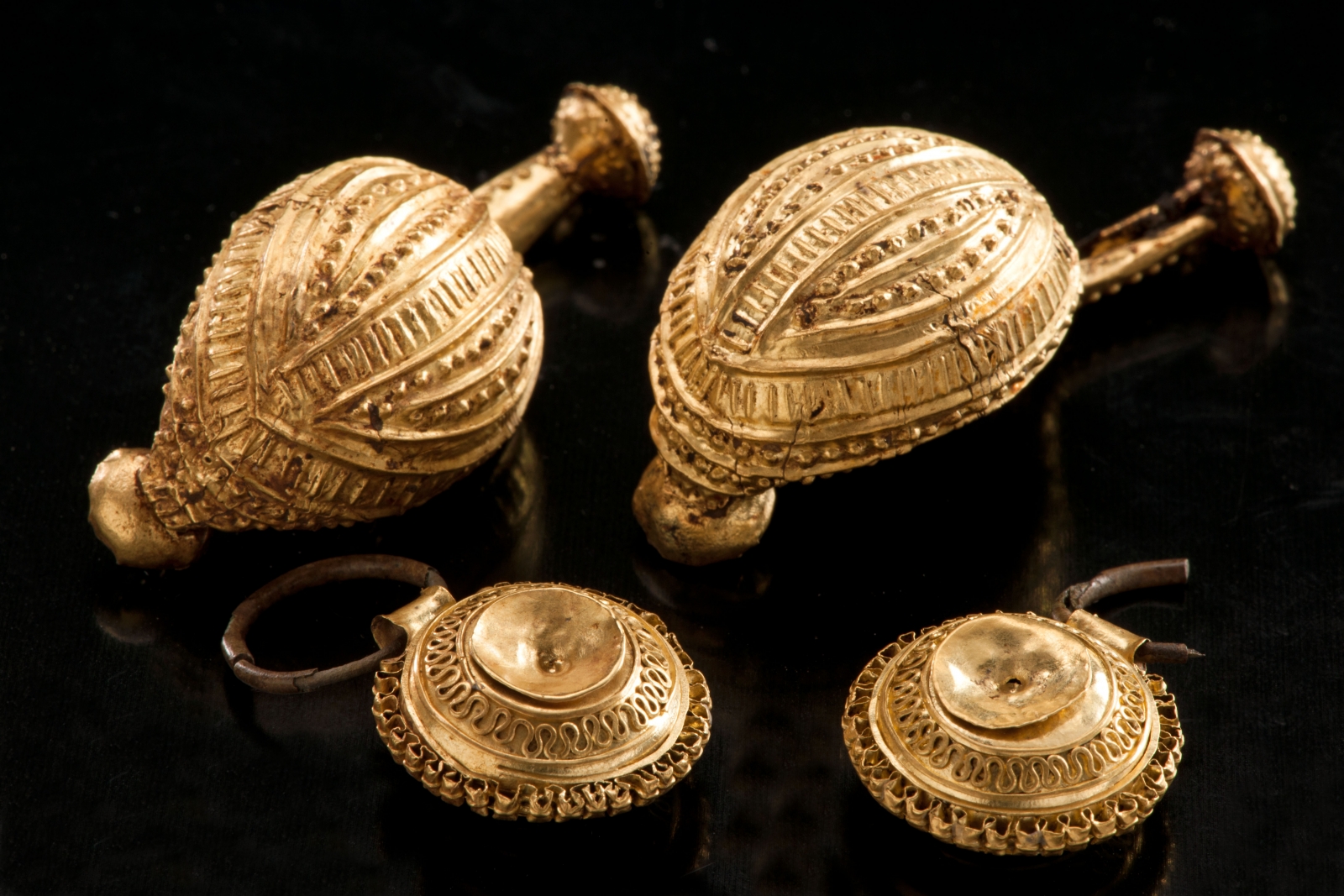Treasures from 2,600-year-old grave of Celtic princess in Germany reveal their secretsFeatures of gold jewellery found in the grave suggest a child found next to the woman was her daughter.
International Business Times
By Martha Henriques January 20, 2017 00:01 GMT Updated 6 hr ago
 Two golden broaches found at the Hueneberg grave. The woman and child found in the grave, dating from Iron Age Europe, were buried with very similar broaches thought to be made by the same goldsmith(Dirk Krausse et al/Antiquity)
Two golden broaches found at the Hueneberg grave. The woman and child found in the grave, dating from Iron Age Europe, were buried with very similar broaches thought to be made by the same goldsmith(Dirk Krausse et al/Antiquity)The grave of an aristocratic woman and child in the south of Germany has been dated to 583 BCE, making it 2,600 years old. The grave site, which was moved to a lab in Stuttgart in its entirety in order for the burial chamber to be studied, contains the remains of a woman adorned in gold, bronze, amber and jet jewellery, and about half a metre away from her, the remains of a girl thought to have been between two and three years old. The woman was buried with gold, bronze, jet and amber jewellery and armour for a horse's head.
Close similarities between the gold broaches worn by the woman and the child suggest that there may have been a familial relationship between the woman and child, archaeologists have reported in
a paper published in the journal Antiquity.
"The broaches are very similar in decoration and style," study author Dirk Krausse of the State Office for Cultural Heritage, Baden-Wuerttemberg, told IBTimes UK. "By typology and ornamentation decoration, they are from the same period – probably from the same goldsmiths."
"They are very special. We have no parallels to compare from the other graves. They're only known up to now from these two graves."
The burial mound is of Celtic origin, from the Iron Age period when the Celts occupied present-day Germany and traded with the rest of Europe. The excavated site was transported to the State Office for Cultural Heritage, Baden-Wuerttemberg in 2011.
The location of this particular grave is likely to be the reason both for the preservation of the remains and the absence of looting.
 Mounted boars’ tusks with tulip-shaped bronze pendants mounted on a trapezoid pendant and two transverse bronze strips found at the Hueneberg site. The length of the teeth are approximately 20cm(Dirk)
Mounted boars’ tusks with tulip-shaped bronze pendants mounted on a trapezoid pendant and two transverse bronze strips found at the Hueneberg site. The length of the teeth are approximately 20cm(Dirk)"We were quite surprised that this grave of this woman was not robbed," Krausse said. "It is close to a small river or creek and it is very wet there, so it's a kind of bog. The other graves which were robbed in antiquity lay on drier ground. Most of the time there was water in this grave chamber, so it's not easy to loot."
 The woman and child found buried within half a metre of each other wore very similar earrings, suggesting familial ties. Figure A shows a golden strip earring (length: 28.5cm) and B shows a detail of the filigree decorated pendant (diameter: 2cm)(Dirk Krausse et al/Antiquity)
The woman and child found buried within half a metre of each other wore very similar earrings, suggesting familial ties. Figure A shows a golden strip earring (length: 28.5cm) and B shows a detail of the filigree decorated pendant (diameter: 2cm)(Dirk Krausse et al/Antiquity)The waterlogged, low-oxygen conditions also preserved the grave from degradation. Biological remains have been retrieved from the woman's skeleton, but there are not enough remains from the child to do a DNA test, Krausse said. Only the enamel from the child's teeth now remains.
At the moment, DNA sequencing technology is not advanced enough to work on the fragments of biological remains from the child's grave. "But in 10 years, 20 years, maybe we will have the technology," Krausse said.
 An illustration of a delicate bronze belt found at the site, generated using X-ray computer tomography(Dirk Krausse et al/Antiquity)http://www.ibtimes.co.uk/treasures-2600-year-old-grave-celtic-princess-germany-reveal-their-secrets-1602047
An illustration of a delicate bronze belt found at the site, generated using X-ray computer tomography(Dirk Krausse et al/Antiquity)http://www.ibtimes.co.uk/treasures-2600-year-old-grave-celtic-princess-germany-reveal-their-secrets-1602047